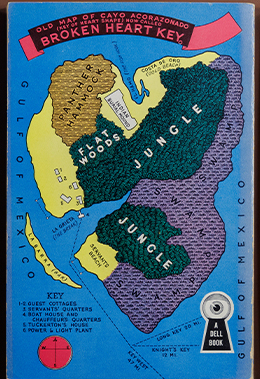Dell Mapbacks: Bright and Cheesy
They just popped off the rack in the midcentury, those Dell mapbacks, the pulp series with dramatic, cheesy covers and bright maps on the back. Who could resist?
Guys, dames, gunshots, cops, killers, a little romance, a little naughtiness — they had it all, kid. “Curtains for the Copper.” “Hearses Don’t Hurry.” “Blood on the Black Market.” “Memo to a Firing Squad.” Big-shot writers like Agatha Christie, Dashiell Hammett, Erle Stanley Gardner. Top-shelf artists such as Ruth Belew, Robert Stanley and Gerald Gregg. That Dell logo, or colophon, an eyeball staring at you through a keyhole, a nice little voyeuristic touch.
Flip the title over, and there was a color map of the house where this guy got dead, that island where things went south, these cutaway floor plans, those mean streets.
They were crazy popular, too, starting in 1943 and running for more than 600 titles for nearly a decade. Mostly mysteries, nearly all reprints of earlier hardcover titles, sure, but a few romances, Westerns, sci-fi and nonfiction narratives from World War II thrown in. Put them together and you have a slice of Americana at the middle of a difficult century, a country emerging as one of the world’s great powers but still uneasy with itself, letting off a little cultural steam.
 The maps for “Midnight Sailing,” “The Iron Spiders” and “The Strawstack Murders.” Rare Book and Special Collections Divison. Photo: Shawn Miller.
The maps for “Midnight Sailing,” “The Iron Spiders” and “The Strawstack Murders.” Rare Book and Special Collections Divison. Photo: Shawn Miller. You can go down quite the rabbit hole with the Library’s collection of these in the Rare Book and Special Collections Division, a near complete run of the series. It’s courtesy of Helen Meyer, the chair of Dell Publishing Company, who orchestrated their donation to the Library in 1976 as part of a larger collection of more than 6,000 titles. (They’re available in used bookstores and online, too, most just for a couple of bucks.)
The mapbacks in particular, and Dell paperbacks in general, were cheap, compact and made to take anywhere. (True confession: I have 1949’s “The Corpse Came Calling” by Brett Halliday on my desk, and it is perfect in every way.)
These books didn’t mess around, either. There was a plot summary right up front, along with thumbnail character descriptions and a list of clues before the story even started.
Let’s meet our femme fatale in “See You in the Morgue,” a 1946 tale by Lawrence G. Blochman, a popular and prolific mystery writer of the era: “JULIA FRYE, who normally had the face of a Madonna by a highly stylized modern painter, but when she looked at Pierre she was an untamed animal.” Next, we learn PIERRE LAURENT teaches French and bridge (as one does), and is “sleek and glib, with a tiny hair-line moustache, an intriguing foreignness, and a way with women.”
Throw in some clues listed on the following page (“A crumpled, bloodstained HANDKERCHIEF… Artificial animal EYES … Mysterious telephone MESSAGES”) and we’re off to some all-caps MAYHEM.
 A closer look at the mapback for “The Iron Spiders” by Baynard H. Kendrick. Rare Book and Special Collections Division. Photo: Shawn Miller.
A closer look at the mapback for “The Iron Spiders” by Baynard H. Kendrick. Rare Book and Special Collections Division. Photo: Shawn Miller.
Pulps of the period have long been fondly regarded by collectors, and mapbacks have been catalogued in several books and online sites, including the extensive The Mapback Index. They weren’t meant to last but they have — and taken together, they’re a small window into another time, preserved at the Library, where they remain a delight.
Subscribe to the blog— it’s free!
Library of Congress's Blog
- Library of Congress's profile
- 73 followers



